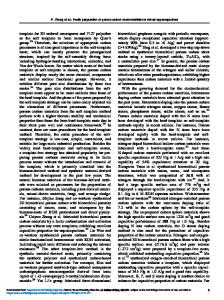Curvature effects in carbon nanomaterials: Exohedral versus endohedral supercapacitors
- PDF / 1,538,377 Bytes
- 7 Pages / 584.957 x 782.986 pts Page_size
- 61 Downloads / 454 Views
Gleb Yushin School of Materials Science and Engineering, Georgia Institute of Technology, Atlanta, Georgia 30332-0245
Cristelle Portet and Yury Gogotsib) Department of Materials Science and Engineering, A.J. Drexel Nanotechnology Institute, Drexel University, Philadelphia, Pennsylvania 19104 (Received 15 January 2010; accepted 22 February 2010)
Capacitive energy storage mechanisms in nanoporous carbon supercapacitors hinge on endohedral interactions in carbon materials with macro-, meso-, and micropores that have negative surface curvature. In this article, we show that because of the positive curvature found in zero-dimensional carbon onions or one-dimensional carbon nanotube arrays, exohedral interactions cause the normalized capacitance to increase with decreasing particle size or tube diameter, in sharp contrast to the behavior of nanoporous carbon materials. This finding is in good agreement with the trend of recent experimental data. Our analysis suggests that electrical energy storage can be improved by exploiting the highly curved surfaces of carbon nanotube arrays with diameters on the order of 1 nm.
I. INTRODUCTION
New technologies for electrical energy conversion and storage are needed to harness sustainable and renewable energy sources, such as solar and wind power. Supercapacitors, or ultracapacitors, that store electrical energy in an electric double layer formed at the electrode/electrolyte interface have recently attracted a great deal of attention as efficient energy storage devices that feature high power density and exceptional cycle life.1–7 As opposed to batteries, this energy storage mechanism does not involve chemical reactions, which are relatively slow. The performance of carbon-based supercapacitors has been significantly enhanced in the past decade, with the development of various nanoporous carbon materials with high surface areas, such as activated carbons, template carbons, and carbide-derived carbons, among others.7–9 In order for supercapacitors to compete with existing battery technology, an energy density higher than currently available is essential while retaining a Address all correspondence to these authors. a) e-mail: [email protected] b) e-mail: [email protected] This author was an editor of this focus issue during the review and decision stage. For the JMR policy on review and publication of manuscripts authored by editors, please refer to http://www. mrs.org/jmr_policy DOI: 10.1557/JMR.2010.0195 J. Mater. Res., Vol. 25, No. 8, Aug 2010
http://journals.cambridge.org
Downloaded: 06 Oct 2014
high power capability. Theoretical descriptions of charge storage processes at the electrode/electrolyte interface are needed to facilitate progress along this avenue. Supercapacitors that use nanoporous carbons as electrode materials are commonly described as electric double-layer capacitors (EDLCs) because of the electric double layer formed at the electrode/electrolyte interface. In the field of supercapacitors, the formula of capacitance for nanoporous carbon materials is often b
Data Loading...











